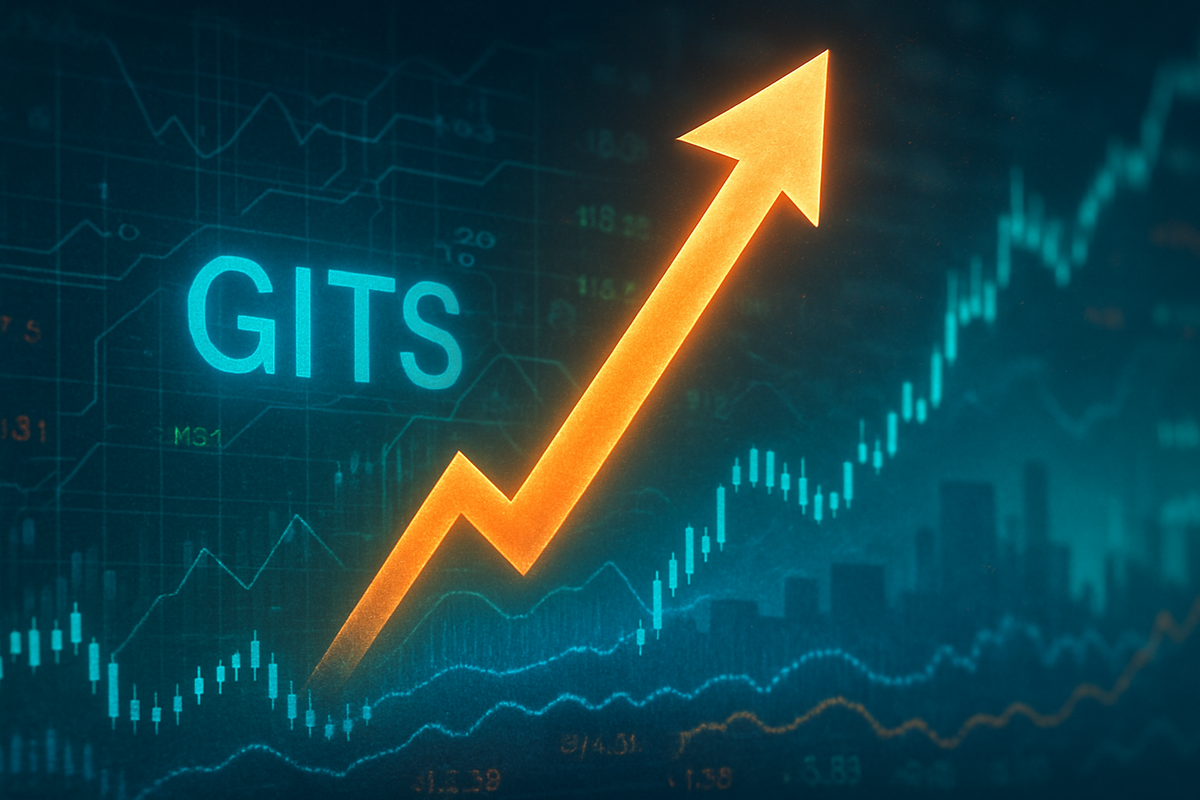
The financial markets, as of October 17, 2025, are grappling with a complex interest rate environment that continues to exert significant pressure on growth-oriented companies, particularly those in the technology sector. While the Federal Reserve recently initiated a 25-basis point rate cut in September 2025, bringing the benchmark rate to 4.00%-4.25%, and signaling further potential easing, the overarching sentiment reflects a sustained period of elevated capital costs compared to the ultra-low rates of previous years. This dynamic poses considerable challenges for firms like GITS, which rely heavily on future growth projections and external financing to fuel their ambitious expansion plans.
The immediate implication for the market is a recalibration of valuations, especially for companies whose worth is largely derived from anticipated long-term earnings. Investors are increasingly scrutinizing profitability and cash flow, shifting away from the aggressive growth-at-all-costs narratives that once dominated the tech landscape. This pivot creates a challenging backdrop for companies like GITS, necessitating strategic adaptations in financial planning, operational efficiency, and investor communication to navigate these evolving economic currents successfully.
GITS Faces Valuation Headwinds Amidst Higher Capital Costs
GITS, a prominent Software-as-a-Service (SaaS) provider specializing in AI-driven data analytics solutions for enterprises, finds its business model particularly susceptible to the current interest rate environment. The company's strategy involves substantial upfront investments in research and development to maintain its competitive edge in AI technology, coupled with aggressive sales and marketing efforts to acquire new enterprise clients. While GITS generates revenue primarily through recurring subscription fees and focuses on capturing market share, it may not yet be consistently profitable, making it highly dependent on external capital.
The sustained period of higher interest rates, despite the recent modest cut, has several profound effects on GITS. Firstly, the increased cost of borrowing directly impacts its ability to fund innovation and expansion. Any debt financing sought for developing new AI features or expanding its platform becomes more expensive, potentially forcing GITS to scale back its ambitious R&D pipeline or accept higher financing costs that erode future profit margins. Secondly, and perhaps most significantly, GITS's valuation, like many growth stocks, is heavily predicated on the discounted present value of its projected exponential growth and future profitability. Higher discount rates, a direct consequence of elevated interest rates, substantially reduce the present value of these anticipated future earnings, exerting downward pressure on GITS's stock price (NASDAQ: GITS) even if its operational performance remains robust.
The timeline of events leading to this moment includes a series of aggressive rate hikes initiated by the Federal Reserve in 2022-2024 to combat persistent inflation, culminating in benchmark rates reaching levels not seen in over a decade. While the September 2025 rate cut signals a potential shift towards easing, the overall cost of capital remains significantly higher than the preceding era of near-zero interest rates. Key players involved are the Federal Reserve, whose monetary policy decisions directly influence borrowing costs, and institutional investors, who are reallocating capital based on risk-adjusted returns. Initial market reactions have shown a general preference for value stocks and companies with strong balance sheets and immediate profitability, often at the expense of high-growth, unprofitable tech firms like GITS. This environment also reduces investor appetite for riskier equity investments, as safer fixed-income assets offer more attractive yields.
Identifying Market Winners and Losers in a Higher Rate Regime
The current financial climate, characterized by elevated interest rates (even with recent cuts), creates a clear bifurcation in the market, distinguishing companies that are poised to thrive from those that face significant headwinds. For a growth-oriented tech company like GITS, the implications are largely challenging, positioning it among the potential "losers" in this environment without significant strategic adjustments.
Potential Losers: Companies like GITS, which are in their aggressive growth phase and not yet consistently profitable, are particularly vulnerable. Their reliance on future earnings for valuation means higher discount rates disproportionately impact their stock prices. Increased borrowing costs make it more expensive to fund essential R&D, marketing, and talent acquisition, which are critical for their expansion. Furthermore, a broader economic slowdown induced by higher rates can lead enterprise clients to tighten budgets, extending sales cycles and tempering GITS's revenue growth. Other companies in this category include highly leveraged firms across various sectors, startups heavily dependent on venture capital (which also faces higher hurdle rates), and companies with business models that require continuous, large-scale capital injections without immediate returns.
Potential Winners: Conversely, several types of companies tend to benefit or are more resilient in a higher interest rate environment. Financial institutions (banks), for example, often see improved net interest margins as they can charge more for loans while the cost of deposits may not rise as quickly. Companies with strong balance sheets, low debt, and consistent profitability are also well-positioned. These firms are less reliant on external financing and may even benefit from higher interest income on their cash reserves. Value stocks in mature industries, often characterized by stable dividends and lower growth expectations, become more attractive as their current earnings are valued more highly relative to distant future prospects. Additionally, companies in defensive sectors such as utilities, consumer staples, and healthcare, which provide essential goods and services, tend to perform better as their demand is less elastic to economic fluctuations. Established tech giants with substantial free cash flow and diversified revenue streams might also fare better, as they can self-fund innovation and even acquire struggling smaller competitors at lower valuations.
Broader Implications and Historical Parallels
The current interest rate dynamics, while showing signs of potential easing, fit into a broader industry trend of market maturity and a re-evaluation of valuation metrics for technology companies. The era of "growth at any cost," fueled by historically low interest rates and abundant cheap capital, appears to be drawing to a close. This shift forces a greater emphasis on sustainable business models, profitability, and efficient capital allocation across the tech sector. The ripple effects extend beyond individual companies, influencing the entire ecosystem of venture capital funding, mergers and acquisitions, and talent retention. Startups may find it harder to secure funding, leading to consolidation or a greater focus on lean operations from inception.
Regulatory and policy implications are also at play. Central banks globally are grappling with balancing inflation control with economic growth. The Federal Reserve's actions set a precedent and influence other central banks, creating a synchronized global financial environment. While direct regulatory changes specific to interest rates impacting tech are limited, the broader economic conditions fostered by monetary policy can spur discussions around market concentration, anti-trust concerns, and the stability of the financial system, particularly if a prolonged period of high rates leads to widespread corporate distress.
Historically, periods of rising interest rates have often led to corrections in asset prices, especially for long-duration assets like growth stocks. For instance, the tech bubble burst of the early 2000s, though triggered by multiple factors, saw a re-evaluation of highly speculative tech stocks as capital became scarcer and investors demanded profitability. More recently, the sharp increase in rates from 2022-2024 significantly impacted tech stock valuations, demonstrating the sensitivity of these companies to monetary policy shifts. While the current scenario involves a more controlled and anticipated rate adjustment, the fundamental principle remains: higher rates increase the cost of capital and reduce the present value of future earnings, disproportionately affecting companies valued on distant growth.
The Road Ahead: Adaptation and Emerging Opportunities
Looking ahead, the short-term outlook for GITS and similar growth-oriented tech companies remains one of cautious optimism tempered by ongoing valuation pressures. While the Federal Reserve's recent rate cut and projected easing suggest a potential tailwind, the overall interest rate environment is unlikely to return to the near-zero levels that characterized the previous decade. In the short term, GITS must prioritize capital efficiency, potentially slowing down less critical expansion projects and doubling down on customer retention and maximizing revenue from existing clients. The market will continue to reward companies demonstrating a clear path to profitability and sustainable free cash flow.
In the long term, strategic pivots and adaptations will be crucial. GITS may need to explore alternative financing mechanisms, such as strategic partnerships or even M&A opportunities, to secure capital and accelerate market penetration without solely relying on traditional debt or equity markets. The emphasis will shift from pure top-line growth to profitable growth, meaning a more disciplined approach to customer acquisition costs and operational expenditures. This environment also presents opportunities for market consolidation, where well-capitalized companies might acquire smaller, struggling competitors at attractive valuations.
Potential scenarios include a continued gradual easing of rates, providing some relief but still maintaining a higher cost of capital than before. Alternatively, renewed inflationary pressures could force central banks to reverse course, leading to further rate hikes and renewed market volatility. Investors should watch for further guidance from the Federal Reserve, inflation data, and GITS's quarterly reports for indications of its ability to adapt. Companies that can demonstrate resilience, innovate efficiently, and achieve profitability will be best positioned to thrive in this evolving landscape.
Market Resilience and Lasting Impact
In wrapping up, the recent movements in interest rates, despite a modest cut in September 2025, underscore a fundamental shift in the financial markets. The era of readily available cheap capital that fueled exponential, often unprofitable, growth in the tech sector has largely concluded. For companies like GITS, the key takeaway is the imperative to balance aggressive growth ambitions with stringent financial discipline and a clear trajectory towards profitability. The market is no longer solely valuing future potential but demanding tangible results and efficient capital allocation in the present.
Moving forward, the market will likely continue to exhibit a preference for companies with robust balance sheets, consistent cash flows, and proven profitability. Investors will remain discerning, scrutinizing business models for sustainability and resilience against economic headwinds. This does not spell the end for innovation or growth, but rather a maturation of the market where viable, profitable growth will be paramount.
The lasting impact of this period will be a more disciplined approach to capital allocation across the tech industry, a stronger emphasis on unit economics, and potentially a more rational valuation framework for growth companies. What investors should watch for in the coming months are further signals from central banks regarding future rate adjustments, inflation trends, and, crucially, how companies like GITS adapt their strategies to this new financial reality. The ability to innovate efficiently, manage costs effectively, and demonstrate a clear path to sustainable profitability will be the ultimate determinants of success in this evolving market.
This content is intended for informational purposes only and is not financial advice







